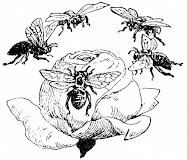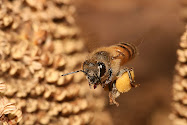
May: Downward is Beeward
If there’s a trend from the last post a few weeks ago, it’s that the bees are moving vertically, from the established heights of the flowering trees, to the understory shrubs, and finally to the new season’s emerging growth and groundcovers. Downward is beeward.
You need water if you are to bloom and the rain in the last part of April helped out. We even got a full on gulley washer to cleanse the town of the excess pollen from the old school wind pollinated plants. There’s something to be said for not going along with the latest evolutionary fad, but the massive pollen bombing really highlights the compact economy of bee pollination. Bees may be the most direct path from anther to stigma – and that’s nothing to sneeze at.
The flowering spring trees have left the stage after a great first act and moved onto the more serious business of photosynthesis. While their collaboration with bees and other pollinators is finished for the year, we can still look forward to their second and third acts as they fruit and colorfully senesce. So thanks trees, we’ll catch up with you later.
Here’s what I’ve noticed in the past couple of weeks:
The yellow leaves of locust trees look great, but we need to be attentive to the details with these guys. Honey locusts, despite their name, don’t offer much to bees. The black locust is a much more interesting nectar source, but it typically doesn’t produce in consecutive seasons and last year was a banner year.
A few shrubs like the viburnums, azaleas and rhododendrons have begun to bloom, proving that the woody plants still have something to offer.

 Closer to the ground, the dandelions and violets are still going strong in unmowed areas. In my yard, they’ve been joined by a white wildflower and a purple flowering groundcover. I’m not exactly sure what they are, but the bees are into them.
Closer to the ground, the dandelions and violets are still going strong in unmowed areas. In my yard, they’ve been joined by a white wildflower and a purple flowering groundcover. I’m not exactly sure what they are, but the bees are into them.As a side note while we’re looking at the ground, look for young ants that still have their wings. These hymenopteran relatives of bees fly to new areas in order to establish a new colony and then lose the wings when they head underground. Feel free to roll out the welcome mat for your new neighbors in the garden.
Moving our gaze upwards slightly to the season’s new growth, we see a few edibles that are teasingly close to flowering. Chives have been in bud for a while and the raspberries are starting to think about flowers. Also, I’ve received great reports about flowering asparagus.
At the moment, overwintered kale is king, shooting seed stalks several feet into the air and showing off bright yellow flowers covered in bees. Who knew that this stodgy green, often beloved by CSA farmers for its hardiness and volume, occasionally bemoaned by CSA subscribers who can’t think of another way to use it, could make such a display?

It’s impressive, and worth investigating further. Kale is an insect pollinated biennial that will cross with other brassicas if they are within a certain range. Since bees display remarkable floral fidelity, only visiting the same kind of plant on a foray, how do these outbreeding crosses happen? In my ignorance, I’m going to blame flies. At any rate, long live kale!
It’s neat to see the bees on flowers at different elevations. Vertical diversity can be a pretty interesting element to our pollinator garden so let’s continue to watch for more examples as the season progresses.
- - - Jeff Irwin
Post your comments to Jeff - and observations on what's UP in your neck of the woods - directly below.
And watch for Jeff's column on the First Sunday of every month.



Hey Jeff! Thanks for the fantastic pollinator periscope. I love the sweep from the treetops to the ground. I did not know that kale was pollinated. Word! I'm not sure what the cheery little white flowers are, but I'm pretty sure that the blue ground cover is ajuga (aka "bugleweed"). Some complain about its invasiveness, but I love to see it poke up in the grass around our place. Thanks for all the thought you put into writing this! --Jennie
ReplyDeleteThe locusts put out a lot of flowers again this year, and the bees worked them hard when weather permitted. The beekeeper regrets every rainy day during the locust flow!
ReplyDelete